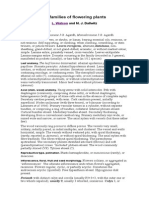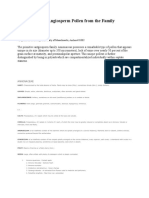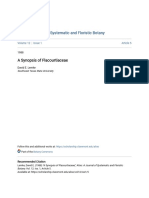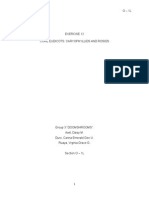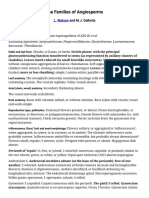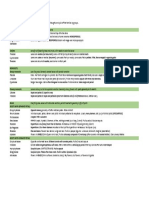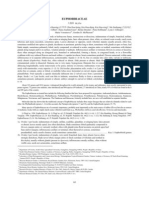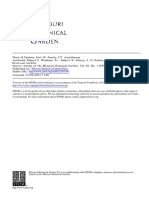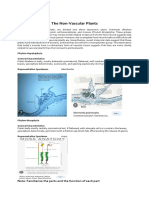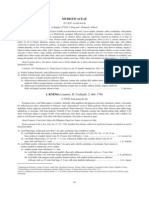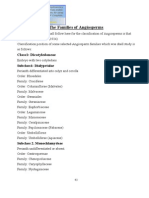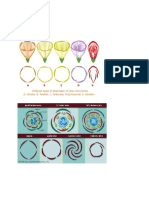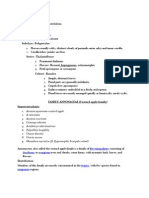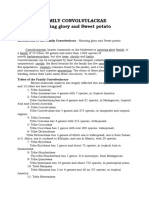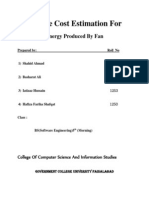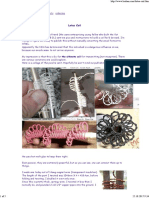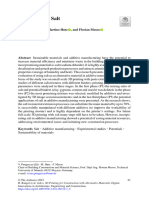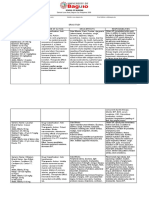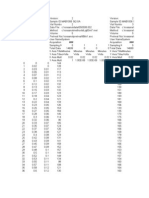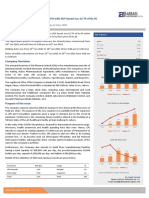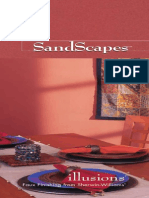0 ratings0% found this document useful (0 votes)
61 viewsAssignment
Assignment
Uploaded by
Ahmad ShahidThis document provides a classification of the Annonaceae plant family. It discusses the following key points in 7 sections:
1. The family includes 130 genera and 2,300 species of woody trees, shrubs and vines. Leaves are simple, alternate and distichous. Flowers are bisexual and actinomorphic.
2. Classification is based on plant habit and leaf form, leaf anatomy, axial anatomy including stem and wood structure.
3. Reproductive characteristics include hermaphroditic, monoecious or dioecious plants. Inflorescences are solitary or racemose. Flowers are regular and cyclic.
4. The perianth has
Copyright:
© All Rights Reserved
Available Formats
Download as PPTX, PDF, TXT or read online from Scribd
Assignment
Assignment
Uploaded by
Ahmad Shahid0 ratings0% found this document useful (0 votes)
61 views11 pagesThis document provides a classification of the Annonaceae plant family. It discusses the following key points in 7 sections:
1. The family includes 130 genera and 2,300 species of woody trees, shrubs and vines. Leaves are simple, alternate and distichous. Flowers are bisexual and actinomorphic.
2. Classification is based on plant habit and leaf form, leaf anatomy, axial anatomy including stem and wood structure.
3. Reproductive characteristics include hermaphroditic, monoecious or dioecious plants. Inflorescences are solitary or racemose. Flowers are regular and cyclic.
4. The perianth has
Original Description:
shahid
Original Title
Presentation
Copyright
© © All Rights Reserved
Available Formats
PPTX, PDF, TXT or read online from Scribd
Share this document
Did you find this document useful?
Is this content inappropriate?
This document provides a classification of the Annonaceae plant family. It discusses the following key points in 7 sections:
1. The family includes 130 genera and 2,300 species of woody trees, shrubs and vines. Leaves are simple, alternate and distichous. Flowers are bisexual and actinomorphic.
2. Classification is based on plant habit and leaf form, leaf anatomy, axial anatomy including stem and wood structure.
3. Reproductive characteristics include hermaphroditic, monoecious or dioecious plants. Inflorescences are solitary or racemose. Flowers are regular and cyclic.
4. The perianth has
Copyright:
© All Rights Reserved
Available Formats
Download as PPTX, PDF, TXT or read online from Scribd
Download as pptx, pdf, or txt
0 ratings0% found this document useful (0 votes)
61 views11 pagesAssignment
Assignment
Uploaded by
Ahmad ShahidThis document provides a classification of the Annonaceae plant family. It discusses the following key points in 7 sections:
1. The family includes 130 genera and 2,300 species of woody trees, shrubs and vines. Leaves are simple, alternate and distichous. Flowers are bisexual and actinomorphic.
2. Classification is based on plant habit and leaf form, leaf anatomy, axial anatomy including stem and wood structure.
3. Reproductive characteristics include hermaphroditic, monoecious or dioecious plants. Inflorescences are solitary or racemose. Flowers are regular and cyclic.
4. The perianth has
Copyright:
© All Rights Reserved
Available Formats
Download as PPTX, PDF, TXT or read online from Scribd
Download as pptx, pdf, or txt
You are on page 1of 11
ASSIGNMENT
Submitted To: Dr. Nusrat Perveen
Submitted By: Mustafa Hussain
Roll No: 1448
Class: MSC(Botany)(M)
Semester: 2
nd
Annonaceae
The Annonaceae are woody trees, shrubs and
vines comprising about 130 genera and 2,300
species. The leaves are simple, alternate, lack
stipules, and generally are distichously arranged
in flat sprays. The flowers are bisexual and
actinomorphic, possessing 3 whorls of perianth
with 3 segments in each whorl. The elongated
floral axis also bears many helically disposed
stamens and several to many simple pistils.
Classification
1) Habit and leaf form.
Trees, or shrubs, or lianas; bearing essential oils;
resinous, or not resinous. Self supporting, or
climbing; when climbing, scrambling, or stem
twiners, or petiole twiners. Leaves evergreen;
alternate;distichous; non-sheathing; gland-dotted, or
not gland-dotted; aromatic, or without marked
odour; simple. Lamina entire; pinnately veined;
cross-venulate. Leaves exstipulate. Lamina margins
entire. Domatia occurring in the family (recorded in 3
genera); manifested as pockets (usually), or hair tufts
(in 1/12 species).
Classification
2) Leaf anatomy.
The leaf lamina dorsiventral. Abaxial epidermis
papillose, or not papillose. Stomata paracytic. Adaxial
hypodermis absent. Lamina with secretory cavities, or
without secretory cavities. Secretory cavities
containing oil, or containing mucilage, or containing
resin. The mesophyll usually with spherical etherial oil
cells (?); containing mucilage cells, or not containing
mucilage cells; with sclerenchymatous idioblasts, or
without sclerenchymatous idioblasts. Main veins
vertically transcurrent. Minor leaf veins without
phloem transfer cells (Annona).
Classification
3) Axial (stem, wood) anatomy.
Young stems with solid internodes. Pith with diaphragms
(commonly, comprising stone cells), or without
diaphragms; heterogeneous (with groups of stone cells
even in the absence of complete septa). Secretory cavities
present; with resin. Cork cambium present; initially
superficial. Nodes unilacunar (with three traces), or
bilacunar (according to Lammers et al 1986). Primary
vascular tissues in a cylinder, without separate bundles, or
comprising a ring of bundles; collateral. Internal phloem
absent. Cortical bundles absent. Medullary bundles absent.
Secondary thickening developing from a conventional
cambial ring. Primary medullary rays wide, or mixed wide
and narrow, or narrow. The axial xylem with vessels (but
these rather few).
Classification
3) Axial (stem, wood) anatomy.
The wood variously ring porous to diffuse porous.
The vessels very small; solitary, radially paired, in
radial multiples, and clustered. The vessel end-walls
horizontal; simple. The vessels without vestured pits;
with spiral thickening (rarely, reported in Asimena),
or without spiral thickening. The axial xylem with
fibre tracheids. The fibres without spiral thickening.
The parenchyma apotracheal. The secondary phloem
stratified into hard (fibrous) and soft
(parenchymatous) zones. Included phloem absent.
The wood commonly partially storied (VP). Tyloses
absent (?).
Classification
4) Reproductive type, pollination
Plants hermaphrodite, or monoecism (rarely), or
dioecious.
5) Inflorescence, floral, fruit and seed
morphology
Flowers solitary, or aggregated in inflorescences.
The ultimate inflorescence units when flowers
aggregated, racemose. Flowers regular; cyclic, or
partially acyclic. Sometimes the androecium
acyclic (spiralled). Free hypanthium absent.
Hypogynous disk present.
Classification
6) Perianth
with distinct calyx and corolla (usually P3+3+3,
with the outer one or two whorls
sepaloid); usually 9; usually 3 whorled;
isomerous. Calyx 3, or 6; usually 2 whorled;
polysepalous; valvate, or open in bud. Corolla 3;
12 whorled; polypetalous; imbricate, or valvate.
Classification
6) Perianth
Androecium usually 25100 (i.e. many).
Androecial members when many, maturing
centripetally; free of the perianth; all equal; free
of one another; rarely 3 whorled, or 6 whorled
(otherwise spiralled). Androecium exclusively of
fertile stamens (usually), or including staminodes
(e.g. in Uvaria spp., where the outer members
may be imperfect). Staminodes when present,
external to the fertile stamens; non-
petaloid. Stamens 25100 (many).
Classification
6) Perianth
Gynoecium usually 10100 carpelled (or more
i.e. many). The pistil when syncarpous, 1 celled,
or 215 celled (or more?). Gynoecium
apocarpous (usually), or syncarpous (rarely); eu-
apocarpous (the carpels spiralled or cyclic), or
synstylovarious to eu-syncarpous
(e.g. Monodora); superior. Carpel 110 ovuled
Classification
7) Fruit
fleshy; an aggregate (commonly an aggregate of
berries). The fruiting carpels coalescing into a
secondary syncarp, or not coalescing. The fruiting
carpel indehiscent; baccate. Seeds
endospermic. Endospermruminate (by contrast
with Magnoliaceae); oily. Seeds with amyloid.
Embryo achlorophyllous (4/5).
You might also like
- Trees of Papua New Guinea: Volume 3: Malvales to ParacryphialesFrom EverandTrees of Papua New Guinea: Volume 3: Malvales to ParacryphialesNo ratings yet
- The Families of Flowering PlantsDocument3 pagesThe Families of Flowering PlantsDann VergaraNo ratings yet
- Unique Type of Angiosperm Pollen From The Family Annonaceae: James W. WalkerDocument4 pagesUnique Type of Angiosperm Pollen From The Family Annonaceae: James W. Walkermagicman20202000No ratings yet
- K 4-6 (-14) C 8 - (0) A G (3 - ), Superior or InferiorDocument6 pagesK 4-6 (-14) C 8 - (0) A G (3 - ), Superior or InferiorAlbert CorderoNo ratings yet
- 11mesoAM PasDocument135 pages11mesoAM PasBernacci LuísNo ratings yet
- ClusiaceaeDocument47 pagesClusiaceaeNhi PhạmNo ratings yet
- EtymologyDocument11 pagesEtymologyJonee SansomNo ratings yet
- Campanulaceae: Campanula Medium) or Long-Lived (E.g. Lobelia Wollastonii)Document31 pagesCampanulaceae: Campanula Medium) or Long-Lived (E.g. Lobelia Wollastonii)María Mónica Henao-CárdenasNo ratings yet
- Flora of China Volume 19 RubiaceaeDocument312 pagesFlora of China Volume 19 RubiaceaeVillamorchard100% (1)
- Anatomy and Morphology of The Poaceae (Gramineae) - Grass FamilyDocument43 pagesAnatomy and Morphology of The Poaceae (Gramineae) - Grass FamilyPeter B KihiyoNo ratings yet
- Menispermaceae - WikipediaDocument11 pagesMenispermaceae - Wikipediajle_dl100% (1)
- A Synopsis of FlacourtiaceaeDocument16 pagesA Synopsis of FlacourtiaceaeJuan David Rodriguez HurtadoNo ratings yet
- AnnonaceaeDocument27 pagesAnnonaceaemanojtbgri5793No ratings yet
- ConnaraceaeDocument5 pagesConnaraceaemyfire5454No ratings yet
- I. Polypodiopsida (Licopsida) : A. Order: OsmundalesDocument26 pagesI. Polypodiopsida (Licopsida) : A. Order: OsmundalesCDB 1st Semester 2077No ratings yet
- Acanthaceae - Justicia - Wasshausen Brittonia 54 2002Document13 pagesAcanthaceae - Justicia - Wasshausen Brittonia 54 2002Simone MeijonNo ratings yet
- Group 3 O - 1L 1Bsb - CDocument9 pagesGroup 3 O - 1L 1Bsb - CVGRuayaNo ratings yet
- FamiliesDocument61 pagesFamiliesramNo ratings yet
- Angiosperm Families - Asparagaceae Juss.Document2 pagesAngiosperm Families - Asparagaceae Juss.CJ DaodaoenNo ratings yet
- DilleniaceaeDocument3 pagesDilleniaceaeTeguh MuslimNo ratings yet
- Bayer 2003Document87 pagesBayer 2003Juan David Rodriguez HurtadoNo ratings yet
- FISSIDENTACEAE Schimper: Ronald A. PursellDocument13 pagesFISSIDENTACEAE Schimper: Ronald A. PursellCristopher Jimenez OrozcoNo ratings yet
- acanthaceaeDocument17 pagesacanthaceaeomrajegorde862No ratings yet
- Green 2002Document51 pagesGreen 2002ΑΝΑΣΤΑΣΙΑ ΝΕΡΑΝΤΖΗNo ratings yet
- CelastraceaeDocument54 pagesCelastraceaeturz4013No ratings yet
- Flora of China Vol 23 Cyperaceae PDFDocument298 pagesFlora of China Vol 23 Cyperaceae PDFHabibNo ratings yet
- Klasifikasi Bryophyta (Part I) 260214Document39 pagesKlasifikasi Bryophyta (Part I) 260214nabillacintaputriNo ratings yet
- Quick and Dirty 25Document1 pageQuick and Dirty 25Noah RobertsNo ratings yet
- MalvaceaeDocument6 pagesMalvaceaeAstha MishraNo ratings yet
- EuphorbiaceaeDocument152 pagesEuphorbiaceaebirisioNo ratings yet
- Solanaceae: Distribution-And-Types/48409Document5 pagesSolanaceae: Distribution-And-Types/48409Fitrie Sii BismaniacNo ratings yet
- AsterellaDocument34 pagesAsterellaPyooTyoNo ratings yet
- Acevedo-Rodríguez 2020 - Guide To The Genera of Lianas and Climbing Plants in The Neotropics - AnnonaceaeDocument6 pagesAcevedo-Rodríguez 2020 - Guide To The Genera of Lianas and Climbing Plants in The Neotropics - AnnonaceaeMárcio BazanteNo ratings yet
- Regalado 1995. Revision of Philippine Medinilla (Melastomataceae)Document41 pagesRegalado 1995. Revision of Philippine Medinilla (Melastomataceae)earl.mendes2No ratings yet
- ACANTHACEAE - Flora Panama PDFDocument130 pagesACANTHACEAE - Flora Panama PDFJose GuerreroNo ratings yet
- Review NotesDocument4 pagesReview NoteshonnyremotoNo ratings yet
- CucurbitaceaeDocument10 pagesCucurbitaceaeladimeji07No ratings yet
- Vol28 Bry RoelDocument72 pagesVol28 Bry RoelCristopher Jimenez OrozcoNo ratings yet
- Lec # 17-18 (3)Document20 pagesLec # 17-18 (3)emanshahbaz003No ratings yet
- 05 LabiataeDocument4 pages05 Labiataealaa elkadyNo ratings yet
- MyristicaceaeDocument6 pagesMyristicaceaebiowellNo ratings yet
- 3 Endangered Plant SpeciesDocument7 pages3 Endangered Plant SpeciesBharat SinghNo ratings yet
- Bittrich 2018Document8 pagesBittrich 2018David FigueroaNo ratings yet
- Flora Australia 03 Hamamelidales Casuarinales PDFDocument247 pagesFlora Australia 03 Hamamelidales Casuarinales PDF_meianti100% (1)
- The Families of Angiosperms PDFDocument43 pagesThe Families of Angiosperms PDFYekitaS100% (1)
- AESTIVASIDocument12 pagesAESTIVASIannisa kNo ratings yet
- Pteridophytes MorphologyDocument79 pagesPteridophytes MorphologyBoopathiAyyanarM100% (1)
- Class: Dicotyledonae: 1. Annona Squamosa-Custard Apple 2. A.reticulata 3. Annona MuricataDocument3 pagesClass: Dicotyledonae: 1. Annona Squamosa-Custard Apple 2. A.reticulata 3. Annona MuricataDani MathewNo ratings yet
- Family ConvolvulaceaeDocument7 pagesFamily ConvolvulaceaeRaymart NaagNo ratings yet
- Flora MalesianaDocument160 pagesFlora MalesianaNik OthmanNo ratings yet
- Kelompok 9Document52 pagesKelompok 9Claudia MatulessyNo ratings yet
- The Genus Morinda (Rubiaceae) in ThailandDocument9 pagesThe Genus Morinda (Rubiaceae) in ThailandTasnuba JahanNo ratings yet
- Diversity of Seed Plants and Their Systematics by DR Nupur BhowmickDocument26 pagesDiversity of Seed Plants and Their Systematics by DR Nupur Bhowmickdapolra55100% (2)
- desmanthus_virgatusDocument7 pagesdesmanthus_virgatusMuneesh KumarNo ratings yet
- GymnospermDocument25 pagesGymnospermJessa BelleNo ratings yet
- Class XI Liliaceae FamilyDocument17 pagesClass XI Liliaceae FamilySachin PokhrelNo ratings yet
- Reproductive Biology of AngiospermsDocument10 pagesReproductive Biology of AngiospermsSourabh Singh bishtNo ratings yet
- DiagramDocument3 pagesDiagramAhmad ShahidNo ratings yet
- Voice Scientific Calculator: by Bashir Hussain 2009-GCUF-1955-526Document1 pageVoice Scientific Calculator: by Bashir Hussain 2009-GCUF-1955-526Ahmad ShahidNo ratings yet
- Table of ContentsDocument2 pagesTable of ContentsAhmad ShahidNo ratings yet
- Test Case For Different Operation: 1 1+ 9 Test To Pass Pass 18-06-2013 Athar and BashirDocument17 pagesTest Case For Different Operation: 1 1+ 9 Test To Pass Pass 18-06-2013 Athar and BashirAhmad ShahidNo ratings yet
- Software Quality Assurance PlanDocument8 pagesSoftware Quality Assurance PlanAhmad Shahid100% (2)
- Liability Law and Software DevelopmentDocument29 pagesLiability Law and Software DevelopmentAhmad ShahidNo ratings yet
- Software Cost Estimation For: Energy Produced by FanDocument12 pagesSoftware Cost Estimation For: Energy Produced by FanAhmad ShahidNo ratings yet
- Project: Voltage Energy DrinkDocument9 pagesProject: Voltage Energy DrinkAhmad ShahidNo ratings yet
- Dear Maria Hope You Are Fine. Please Find Attached Offer Letters. RegardsDocument2 pagesDear Maria Hope You Are Fine. Please Find Attached Offer Letters. RegardsAhmad ShahidNo ratings yet
- Student Information System Project in PHPDocument3 pagesStudent Information System Project in PHPAhmad ShahidNo ratings yet
- Colloid Chemistry and Phase Rule 4022146-1: (Essentials of Physical Chemistry - Arun Bahl & B.S. Bahl) Chapter 19 and 22Document51 pagesColloid Chemistry and Phase Rule 4022146-1: (Essentials of Physical Chemistry - Arun Bahl & B.S. Bahl) Chapter 19 and 22Razan khalidNo ratings yet
- Wet Transformer? Dry It On-Line No Stops: Now Wet Transformers Can Be Dehydrated Without Being Taken Out of Service!Document2 pagesWet Transformer? Dry It On-Line No Stops: Now Wet Transformers Can Be Dehydrated Without Being Taken Out of Service!Vishwas KaleNo ratings yet
- Lotus PDFDocument5 pagesLotus PDFmatejNo ratings yet
- Toyox ENGDocument69 pagesToyox ENGthu12a1thpthongthaiNo ratings yet
- Dangerous Solid Cargoes in Bulk June 2011Document26 pagesDangerous Solid Cargoes in Bulk June 2011Mohammadreza Vosoughi100% (1)
- Purity Jan 16Document12 pagesPurity Jan 16rajababuNo ratings yet
- Ee2302 - Electrical Machines Ii Question Bank Short Answer QuestionsDocument5 pagesEe2302 - Electrical Machines Ii Question Bank Short Answer QuestionsKarthi RamachandranNo ratings yet
- IATA Hidden Dangerous GoodsDocument3 pagesIATA Hidden Dangerous GoodsMahmood Mushtaq100% (1)
- WKST A Topic 1.1 Change in Tandem 2024Document4 pagesWKST A Topic 1.1 Change in Tandem 2024venkasan002No ratings yet
- Grays Anatomy Students 2SAE 20mayDocument5 pagesGrays Anatomy Students 2SAE 20mayDhuruvan S KNo ratings yet
- KAeserDocument4 pagesKAeserUbanAirlanggaNo ratings yet
- 3D Print With SaltDocument35 pages3D Print With Saltnokia09peterNo ratings yet
- A Metallographic Case Study of Formicary Corrosion in Heat Exchanger Copper TubesDocument12 pagesA Metallographic Case Study of Formicary Corrosion in Heat Exchanger Copper TubesMaría Vaquero TxapartegiNo ratings yet
- DicomWorks Software For Reviewing DICOM Studies AnDocument10 pagesDicomWorks Software For Reviewing DICOM Studies AnAhmed AlkabodyNo ratings yet
- Chapter 5 Drug StudyDocument16 pagesChapter 5 Drug StudyRegee Rose LacsonNo ratings yet
- MAB1006 - ST 2-0 & 2-200Document1,806 pagesMAB1006 - ST 2-0 & 2-200api-3823113No ratings yet
- Flow Over WeirsDocument22 pagesFlow Over WeirsNurfayyadhahtul Syafawani100% (1)
- Agfa CR 35-XDocument82 pagesAgfa CR 35-XPaulo PortelaNo ratings yet
- Abbasi Citi PharmaDocument4 pagesAbbasi Citi Pharmaali ahmadNo ratings yet
- Chem Tech - 300 400 450 500 - DatasheetDocument4 pagesChem Tech - 300 400 450 500 - DatasheetDony IPNo ratings yet
- Rebooting Supply Chains: Shorter, Smarter and More Sustainable ?Document34 pagesRebooting Supply Chains: Shorter, Smarter and More Sustainable ?RobekNo ratings yet
- Research For MR DejeneDocument20 pagesResearch For MR Dejenetakele loveNo ratings yet
- Adult Case History FormDocument11 pagesAdult Case History FormJoozher ElifNo ratings yet
- Worksheet 8 Eng 2Document3 pagesWorksheet 8 Eng 2Abigail BernardezNo ratings yet
- Parts Catalog 2013-1 Sections E-FDocument334 pagesParts Catalog 2013-1 Sections E-FМаксим КрикунNo ratings yet
- 21 Principles Smile Design Lee OstlerDocument43 pages21 Principles Smile Design Lee OstlerRuxandra Murariu100% (7)
- Pantry Inventory List: Dry Goods (Flour, Sugar, Etc.) Qty Canned Goods QtyDocument1 pagePantry Inventory List: Dry Goods (Flour, Sugar, Etc.) Qty Canned Goods QtyAleksandra Živković Ex GavrićNo ratings yet
- Sands CapesDocument3 pagesSands CapesMakv2lisNo ratings yet
- Electricity IjsoDocument3 pagesElectricity IjsoEr Nikunj VelaniNo ratings yet
- RoarDocument3 pagesRoarJochieNo ratings yet

